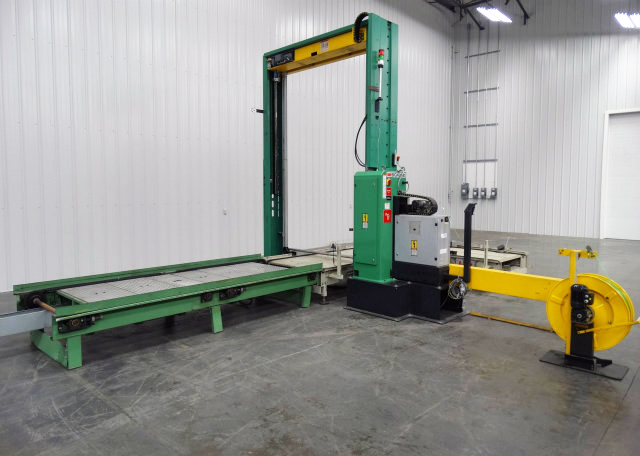How Do Pallet Strappers Work?
Your Guide to what pallet strappers are used for, benefits they provide, how they work, and more
Pallet strappers are highly versatile pieces of equipment and can be utilized across a variety of industries to securely strap products to a pallet. By adding a pallet strapper to your production, you can increase production throughputs and gain assurance that your pallet loads will be correctly fastened for safe handling in the warehouse and/or during transport to the end-user.
SIGMA Equipment is covering all things pallet strappers so that you can learn more about what they’re used for, what benefits come along with incorporating one into your production, how they work, and more. If you would like to talk more in-depth about how pallet strappers can increase your operation’s safety and minimize risk, contact us here.

In this article, we’re going to discuss:
- What are pallet strappers used for?
- What benefits do pallet strappers provide?
- How do pallet strappers work?
- How do I know what size pallet strapper to get?
- What type of pallet strappings should I use?
What are strappers used for?
Pallet strappers are ideally used for lumber, heavy packages, heavy machinery, bricks, tiles, boxes, and cartons. The main goal of a pallet strapper is to prevent your products from becoming damaged during transit, which ultimately will save you time and money.
What benefits do pallet strappers provide?
When preparing a large load of product for transport, some people may think that pallet strapping is an unnecessary cost or waste of time, but really, it is quite the opposite. When a product is consistently and properly strapped, transporters can avoid missed deliveries, unhappy customers, workplace injuries, freight claims, and more.
Another benefit of working with a pallet strapper is that it can lower the number of workers that are required for strapping products. That then opens up the opportunity of redirecting those workers to perform other tasks and thereby increasing the company's efficiency and productivity.
Lastly, using a pallet strapper can help you make the most of your space because the straps used by the pallet strapper are less bulky than pallet wraps or stretch film. In addition to saving space, breaking down a pallet strapper takes less time and creates less waste than a stretch wrapped load. Overall, these three benefits combined make it possible to run a smooth operation when transporting goods.
How do pallet strappers work?
So now that we’ve covered what pallet strappers are best used for and how they can benefit you, let’s dive a little deeper into how they work. Once the pallet load is built upstream from the strapper, a powered roller conveyor moves the pallet into the strapper. Next, when the machines' sensors detect the load, the straps are applied, tightened, and cut. Once the load is completely secured by the pallet strapper, it will then be transported away by another roller conveyor.
In addition to the basic functions of strapping, there may be a few different features available depending on what model you have. These options include:
- Ability to apply either two or four straps
- 90-degree rotation to allow for strapping in one or two directions
- A cardboard edge protection applicator to prevent the straps from "biting" into the load
- Compression tables that center and pre-compacts the load prior to strapping
How do I know what size pallet strapper to get?
Most pallet strappers are compatible with a wide range of products and sizes but one exception is the arch style strapper. With this type of strapper, you need to know the maximum size of the load (W x H) that needs to be strapped in order to choose the optimum arch size.
What type of pallet strappings should I use?
After you’ve found the correct pallet strapper, you will also need to make sure you are using the correct type of strappings. Straps are made with different materials depending on what product type or weight you are securing.
Polypropylene:

- Used for light pallets (i.e. approximately 500-700 pounds)
- Rust and temperature resistant
- Has the highest level of stretch, with little recovery
Polyester:
- Used for relatively heavy loads (i.e. 1200 to 2000 pounds)
- Moisture and UV resistance
- Maximum temperature of 170 degrees F
- Often used as an alternative to metal straps
- High level of elongation and recovery
- Used for loads that may expand or contract in transport
Steel:
- Strongest and suitable for hefty loads (i.e. 4000 pounds)
- Excellent choice for loads with sharp or rough edges, such as concrete, which does not compress
Summary
With the help of a pallet strapper, you’ll be able to safely transport your product in mass quantities without the worry or stress of the load arriving damaged. On top of keeping your product safe, strappings can also keep your facility workers safe, which is even more important. There are different types of strappers and strapping types, determining which one best fits your needs will depend on what you are securing and what its weight is. We recommend a pallet strapper to anyone whose daily operations usually involve moving materials around a warehouse or transporting goods to an end-user.
If you’d like to learn more about pallet strappers or are interested in seeing the models we have available, please click below to get in touch with one of our equipment experts.